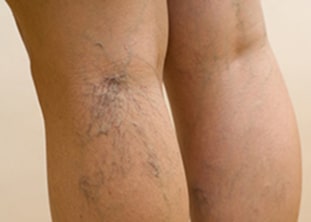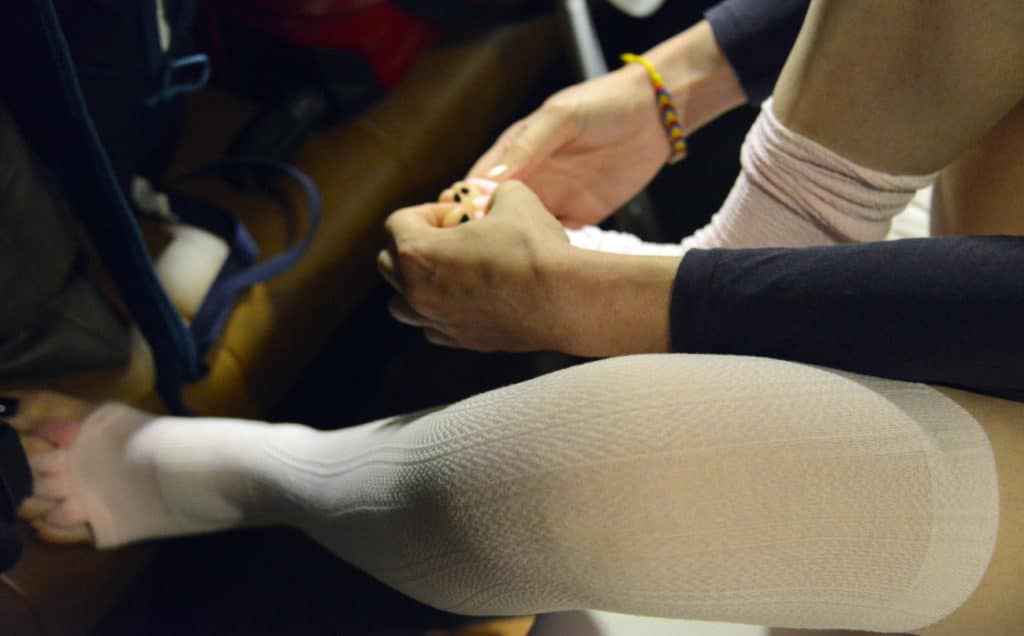Women are more likely to suffer painful spider veins.
Heredity is the number one contributing factor causing varicose and spider veins. Women are more likely to suffer from abnormal leg veins. Up to 50% of American women may be affected. Hormonal factors including puberty, pregnancy, menopause, the use of birth control pills, estrogen, and progesterone affect the disease. Other predisposing factors include aging, standing occupations, obesity, and leg injury.

What Are Spider Veins?
Spider veins are small clusters of tiny veins just below the surface of the skin, showing through on the surface as red, purple, or dark blue. They may look like fine lines, starburst clusters, or a web-like maze. They are more common in women, especially at childbearing age and older. You’ll usually find spider veins on the thighs, ankles, and calves, but they will also develop on the face.
Are Spider Veins Painful? Do They Cause Swelling?
Most spider veins don’t cause any pain, other than the pain of seeing them on your legs. Spider veins rarely are linked with swelling; that’s the domain of larger varicose veins.
At What Age Do Spider Veins Start to Show Themselves?
There isn’t a typical age for the formation of spider veins. As they are linked to hormonal changes, that means any time your body has hormone fluctuations, spider veins can follow. For women, that can be as early as your teenage years, and surely during pregnancy. Of course, menopause is a prime time, but most women have at least a few spider veins before its onset. Also, weight gain and spider veins go hand in hand, so even younger women who gain lots of weight can see spider veins develop.
It’s easy for younger people to think of spider veins showing up on aging legs. It is true that aging increases their appearance. This is probably due to two factors: weakening support tissues and veins in the legs, and thinning skin. Thinning skin may allow formerly unseen clusters to start to show themselves as we pass our 50th birthday.
Can Stress Cause Spider Veins?
Stress is not a factor in the development of spider veins. They are due to long periods of standing for work; hormone fluctuations during pregnancy, menopause, and even when on birth control pills; heredity; and obesity.
How To Prevent Spider Veins
To help prevent development of spider veins and varicose veins, we suggest the following:
- sunscreen
- regular exercise
- proper weight
- avoid crossing legs when sitting for long periods of time
- elevate legs when resting
- avoid sitting or standing for long periods of time
- wear elastic support stockings
- avoid wearing high heel shoes for long periods of time
- eat a low-salt, high fiber diet

Can spider veins cause other health issues?
Spider veins are kind of like mini varicose veins. They form when blood flows backward in small blood vessels due to faulty valves that would typically prevent backflow. Still, they are so small that spider veins usually don’t lead to anything other than an annoyance when you want to put on a swimsuit or a pair of shorts.
They don’t require treatment in the vast majority of cases because they are only a cosmetic nuisance.
What is the difference between spider veins and varicose veins?
Both spider veins and varicose veins are caused by faulty veins allowing blood to leak and backflow. The blood pools rather than flowing through the vessel without any problem.
The difference between the two is size. By definition, spider veins are less than one millimeter in diameter. Varicose veins are greater than three millimeters in diameter.
Because varicose veins are wider, they hold more pooling blood. This makes the malfunctioning veins bulge up through the surface skin, kind of like a lawn with a mole tunnel under the surface. With the increased blood in varicose veins, blood clots can develop as the blood pools, a condition known as superficial vein thrombosis or phlebitis. This can be quite painful.
For spider veins, Dr. Zakhary typically uses sclerotherapy. The size of each varicose vein usually precludes sclerotherapy as a treatment option. Varicose veins are usually treated with an outpatient procedure called ambulatory phlebectomy.
How does Dr. Zakhary diagnose spider veins?
Spider veins typically don’t have any pain associated with them. They are strictly a cosmetic concern. As such, Dr. Zakhary can spot them upon examination of your legs and ankles, and your face. This is simply a visual confirmation.
Patient Testimonial
How Are Spider Veins Removed?
Spider veins can be removed with a procedure known as sclerotherapy. Sclerotherapy can be done in the physician’s office without anesthesia. Patients can return to normal activity right after the treatment.
What are the benefits of sclerotherapy?
The benefit of sclerotherapy is that you can say goodbye to those unsightly clusters of purple, red, and blue veins on your ankles and calves. Once Dr. Zakhary injects the veins, they initially diminish dramatically, fully going away in a few weeks as your body scavenges the closed off veins. You’ll love how your legs look.
Is there any harm in removing spider veins?
No. Sclerotherapy treatments with Dr. Zakhary are easy, safe procedures that instantly improve the appearance of your unwanted spider veins. Sclerotherapy has been around since the 1930s and is very effective and safe. As soon as the vein is injected and the walls close off, the body reroutes any blood to an adjacent, healthy blood vessel.
How do I prepare for spider vein treatment?
There isn’t any preparation necessary for your spider vein treatment with Dr. Zakhary. Prior to your appointment, you’ll want to designate which veins you’d like to treat. He will use sclerotherapy, and these treatments are simple and only take a few minutes. You won’t need to miss any time at work, so you won’t need to prepare for that.
How long does spider vein removal take, and will I need additional treatments?
A sclerotherapy session with Dr. Zakhary is fast, taking just 15-20 minutes in most cases. He can treat multiple spider veins in a single session. One treatment usually removes the vein, but occasionally a larger vein may need a second treatment.
What happens after my treatment session?
In most cases, we’ll put you in compression stockings after your sclerotherapy session, particularly if you’ve had multiple veins treated. These hose improve your body’s ability to heal and absorb the closed off spider veins. You’ll wear them for up to two weeks.
Is there recovery after having sclerotherapy for spider veins?
If Dr. Zakhary injects a number of spider veins, he’ll likely have you wear compression stockings for a week or so after your session. The compression helps the body begin the process of absorbing the closed off veins. Walking and light exercise is fine immediately after your session. If a series of vein clusters have been treated, you should avoid any strenuous exercise for a few days.
Can spider veins disappear on their own?
Spider veins are usually here to stay once the veins have become inefficient and serpentine. Compression hose can keep them from developing, but they won’t make them go away in most cases. That’s the job of sclerotherapy with Dr. Zakhary.

What can I expect from my sclerotherapy results?
As soon as Dr. Zakhary injects the sclerosant into and around the spider vein cluster, the veins usually disappear or dramatically lessen in appearance. The body will then break down and remove the closed-off vein. This area will then be clear of these obnoxious purple and blue squiggly lines. The veins are gone for good. They will not reform again, although you can develop new spider veins in the future.
How can I maintain my results after sclerotherapy?
Spider veins won’t return, at least not the same vein cluster. Once they have reacted to the sclerosant and closed off, the body will scavenge and remove them permanently. We provide a list of tips for preventing spider veins above. The best thing you can do is keep moving. Exercise and avoiding sitting or standing for long periods is your best way to keep your legs clear of these telltale blue and purple clusters. If you do need to be on your feet a lot, compression hosiery can really help.
After all, if the conditions in your legs and lifestyle allowed spider veins to form in the first place, they can do so again.
Will Insurance Cover Sclerotherapy Treatment?
Dr. Zakhary has vast experience in treating spider veins. Most insurance companies will cover this procedure if all alternative treatments have failed, however, we do have very affordable self-pay options available as well.
Non-Surgical Spider Vein Removal
For more complicated conditions such as inflamed varicose veins, other minimally invasive, office-based treatments are available. For more information or to schedule an appointment contacts our office.
Schedule Your Consultation Today
If you’re interested in learning more about spider vein please contact us for a consultation at (623) 258-3255 or fill out our contact us form below. We will discuss your needs and concerns, and determine your best course of action.
